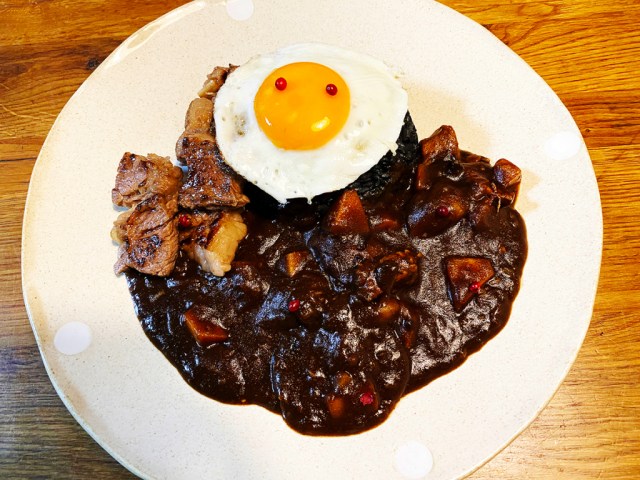
This unique curry that originated at a Japan Ground Self-Defense Force camp in Fukuoka has been making waves online.
A Nishinippon Shimbun article published on June 1 introduced a recipe for making an unconventional version of a favorite Japanese home-style dish. This version, called botayama curry (ボタ山カレー), has been served in the mess hall of the Japan Ground Self-Defense Force (JGSDF) Camp Iizuka in Fukuoka Prefecture since 2008. Our Japanese-language reporter was intrigued by the article and subsequently got in touch with the camp’s PR division to learn more about the curry’s origins and tips for making it himself.
▼ The particular presentation of the curry on its plate hasn’t changed since its initial inception and actually has meaning behind it, as we will see below.
According to the staff, the dish was originally created to boost morale for camp members participating in training drills. In a recent survey of members, many responded that their motivation to work hard goes up on days when botayama curry is being served. Its unusually dark appearance was initially besides the point, but when the dish gained recognition by media outlets and went viral on social media, the salient coloring became the focus and was met with “half surprised, half happy reactions.”
So what is the significance behind not only the black sauce but the black rice as well? “Botayama” refers to a “spoil tip,” or a large pile of accumulated waste rubble collected during coal mining. Some of Japan’s most productive coal mines were located in Iizuka (particularly in Chikuho, a former town merged into Iizuka in 2006) during the country’s period of industrialization, so the dish styles its appearance in a nod to local history.
To achieve that effect, edible bamboo charcoal powder is mixed in with uncooked rice in order to darken its color. Diced steak is also added to evoke the image of coal chunks and a fried sunny-side-up egg represents the full moon peeking over a coal mine.
The actual recipe for botayama curry was recently shared on Camp Iizuka’s Twitter account. This is what our reporter referred to while attempting his own take on the dish.
皆さんこんにちは!飯塚駐屯地です!
— 陸上自衛隊飯塚駐屯地 (@JGSDF_IIZUKA) May 22, 2020
今日は、以前紹介した駐屯地名物ボタ山カレーの調理風景とレシピを公開いたします。
興味のある方は是非ボタ山カレー作りにチャレンジしてみてください!
朝早くから調理していただいている糧食班の方々には感謝でいっぱいです!#飯塚駐屯地 #飯塚市 #筑豊 pic.twitter.com/5lvZojsTjL
The lower-left table lists all ingredients and measurements for one portion of curry. From top to bottom, they are:
- margarine
- minced garlic
- sliced onion
- beef leg meat
- quartered slices of ginseng
- chopped potato
- laurel [bay leaf]
- whole pink pepper
- feitan/妃湯 [a brand of stock; chicken stock can be a substitute]
- curry roux
- Masala kuro [black] curry
- soy sauce
- vegetable oil
- diced steak
- more minced garlic
- steak spices
- egg
- hot spice to your liking
- polished rice
- enhanced polished barley/oats
- edible bamboo charcoal powder
Most of the ingredients can be purchased at a regular Japanese supermarket. Here’s our reporter’s haul after a shopping trip:
There are four main steps in the recipe and three helpful tips.
1. Stir-fry the margarine, minced garlic, and onion well
Add margarine and minced garlic to the sliced onion. Tip 1: Carefully brown for one hour or until whenever the onion caramelizes (becomes amber in color).
2. Rub spices into the diced steak and grill over an iron surface
Rub the spices into the steak well and cook until brown spots appear. The aroma should be enticing at this stage and whet your appetite.
3. Cook the curry as usual
Sauté small chunks of potatoes and carrots in a saucepan. If you want the beef flavor to really stand out later, make sure to cut the vegetables into smaller pieces than the meat.
Here is where you combine the caramelized onion mixture, the diced steak, the other beef leg meat, stock, water, curry sauce, and laurel [bay leaf] together. Cover the pot and let simmer for 40 minutes.
4. After stopping the heat, add the masala kuro curry
Add the masala kuro curry in order to darken the curry produced in Step 3. Tip 2: the curry should be added only after the heat is cut. If it isn’t, the flavor of the masala will diminish.
Now we’ve finished Steps 1-4…but we can’t forget about one final important piece of the puzzle: the rice!
Tip 3 states that edible bamboo charcoal powder (two grams of powder per portion) should be mixed in well with the rice and barley/oats directly prior to cooking. If it’s added too early the grains will become stiff. Other than that addition, the rice mixture should be cooked as usual in a rice cooker using the regular amount of water.
Seeing the powder clouding the water is a strange and not altogether un-appetizing feeling…
Stir together well and let it cook. Upon opening the lid, it should look something like this:
This could be the end, but if you want to follow Camp Iizuka’s instructions to a T there’s one final missing piece: the fried egg that represents a full moon.
Add the cooked egg to the top, decorate with two pieces of pink pepper, and voila–the botayama curry is finished.
Thoughts on the taste
The curry had both sweet and spicy flourishes to it and a depth of flavor. Our reporter thought that it could be evenly loved by people of all ages. There was plenty of volume, especially with the addition of the steak bits and egg, and enough variety to never get tired of it.
The blackened rice certainly left a visual impact. A hint of the charcoal taste went well with the curry, which had also absorbed the water so at its best it could be called refreshing and at its worst it could be called a bit dry. He supposed it would depend on the individual taster but in his mind he though it would go well with thick curries but probably not with soup curries.
▼ SoraNews24’s take on botayama curry
On a final note, he mentions to keep a small mirror nearby because your teeth and lips will darken after eating it–as he found out the hard way from his family’s laughing.
Source: Nishinippon Shimbum, Twitter/@JGSDF_IIZUKA
Images © SoraNews24, Twitter/@JGSDF_IIZUKA (used with permission)
Top image: SoraNews24
● Want to hear about SoraNews24’s latest articles as soon as they’re published? Follow us on Facebook and Twitter!
[ Read in Japanese ]

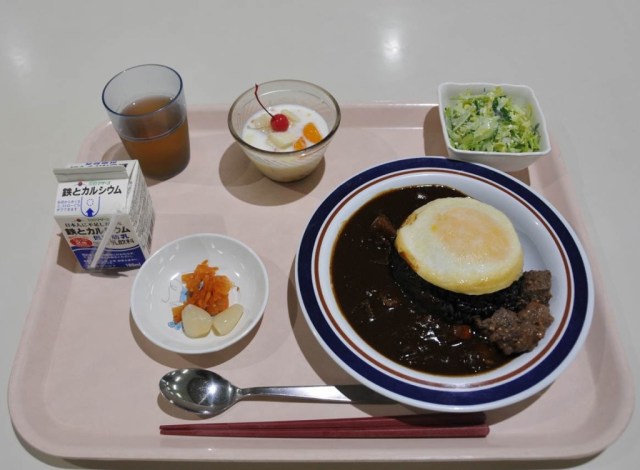
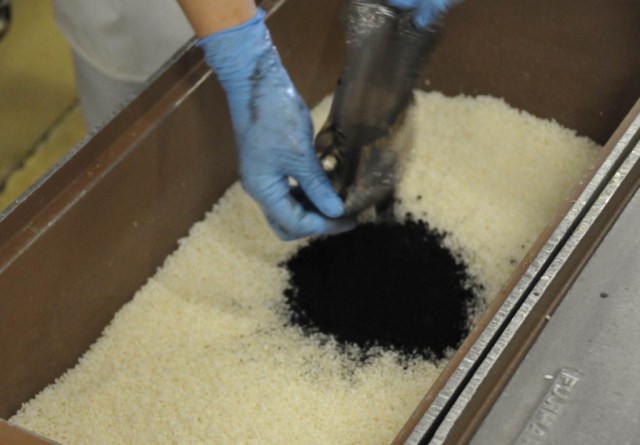
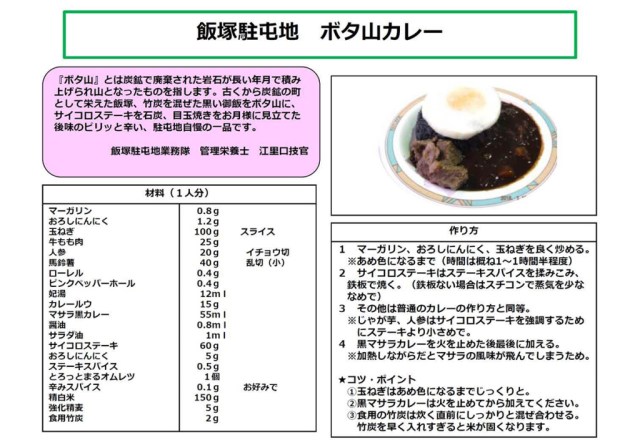
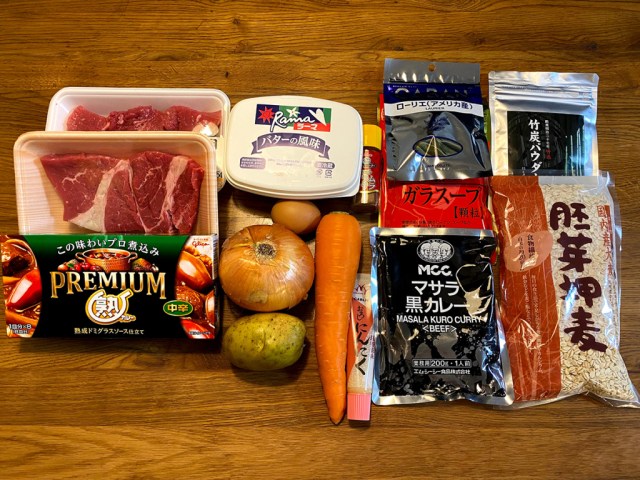
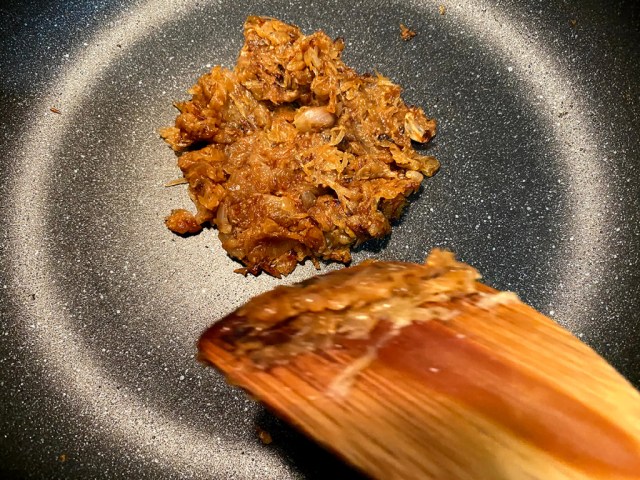
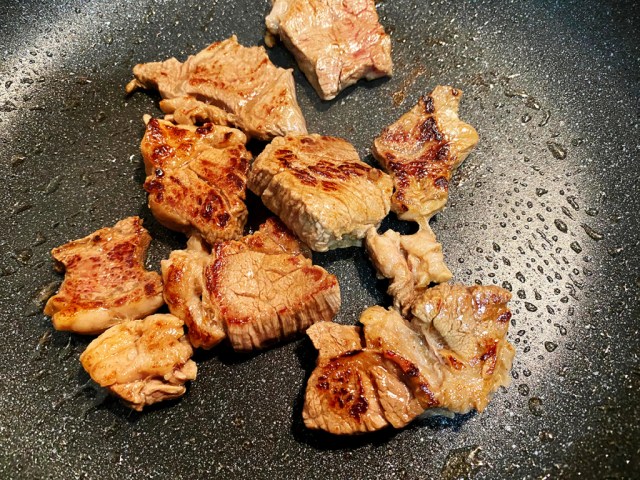
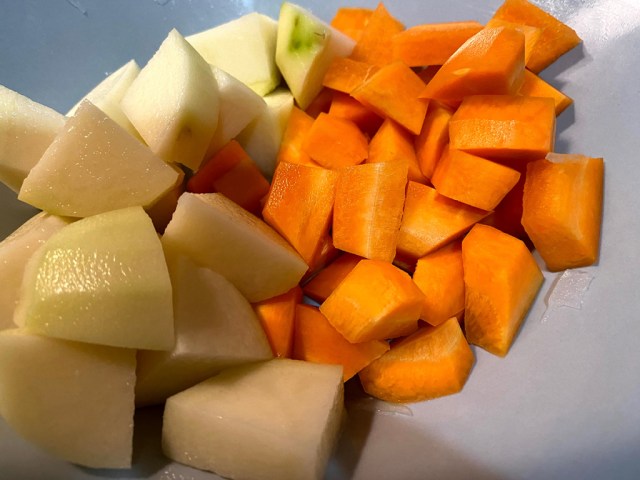
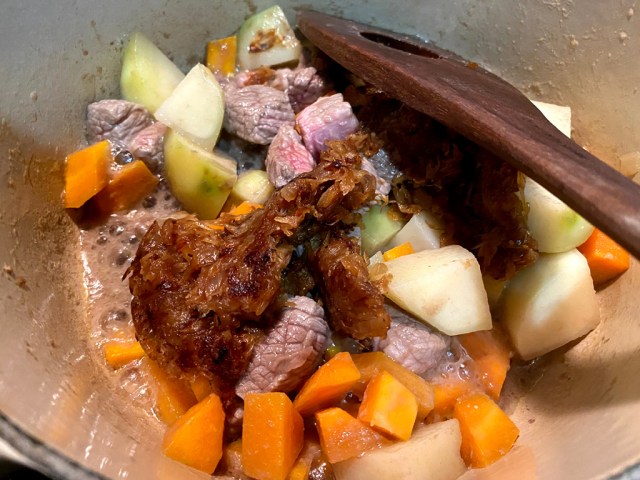
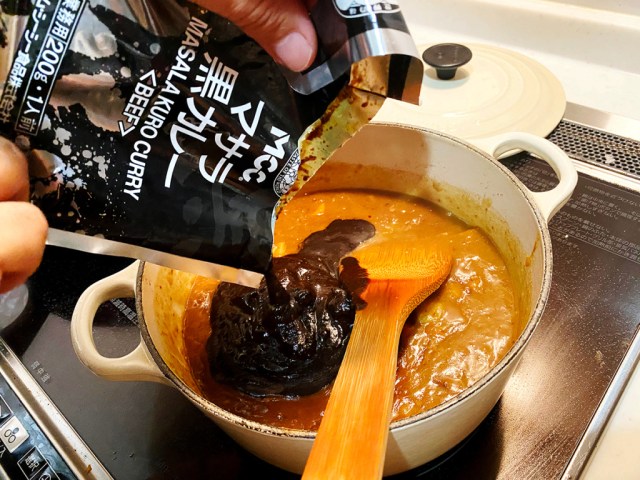
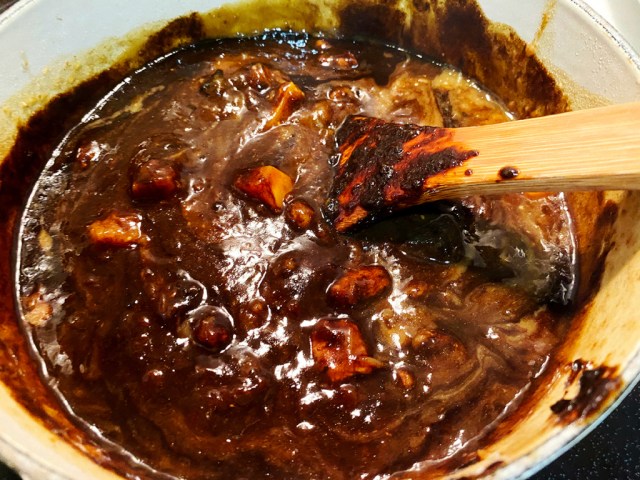
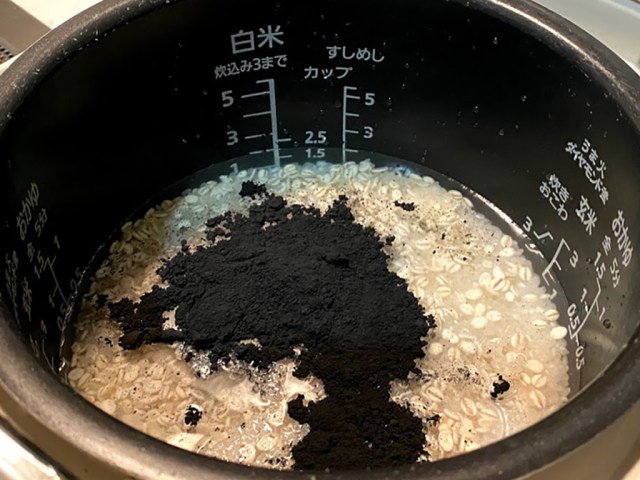
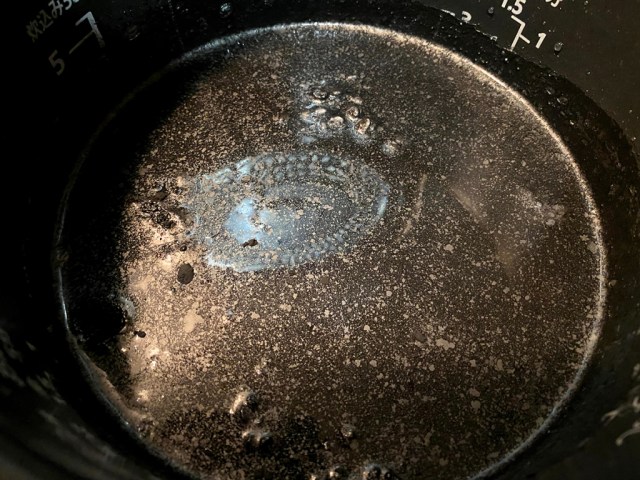
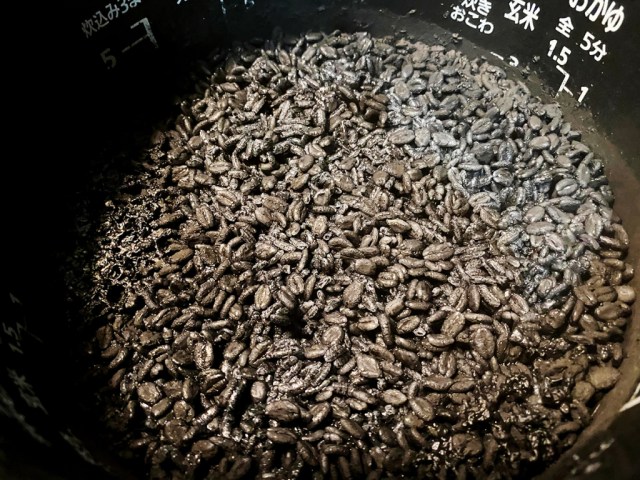
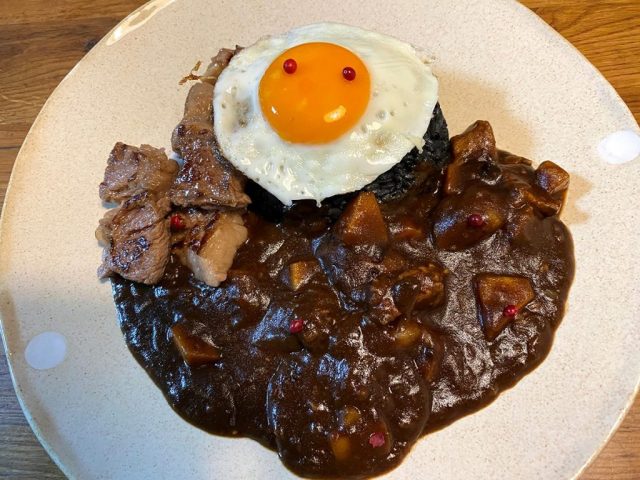
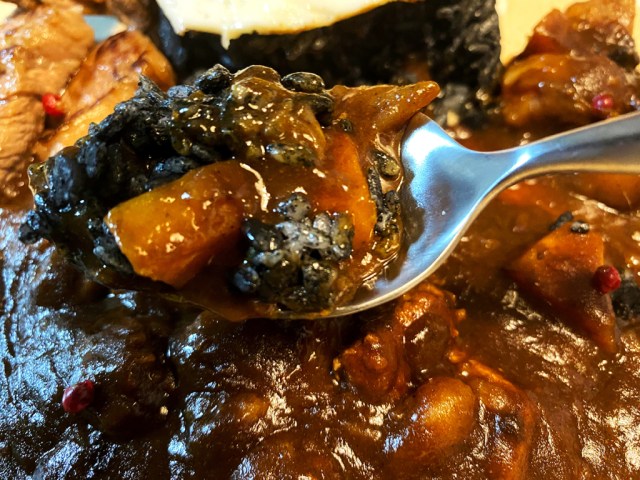
 CoCo Ichibanya now selling Taiwanese Lo Bah Spice Curry for a limited time【Taste test】
CoCo Ichibanya now selling Taiwanese Lo Bah Spice Curry for a limited time【Taste test】 No time to cook? No problem! Three easy ways to improve instant curry
No time to cook? No problem! Three easy ways to improve instant curry Japan’s Gyoza Filling Curry — Combination of two great foods reminds us of another great food
Japan’s Gyoza Filling Curry — Combination of two great foods reminds us of another great food We spice up our fermented soybeans with curry powder flavored natto【Taste Test】
We spice up our fermented soybeans with curry powder flavored natto【Taste Test】 Taste testing 7-Eleven Japan’s five frozen curries to see which ones nail it
Taste testing 7-Eleven Japan’s five frozen curries to see which ones nail it Red light district sushi restaurant in Tokyo shows us just how wrong we were about it
Red light district sushi restaurant in Tokyo shows us just how wrong we were about it Japanese ramen restaurants under pressure from new yen banknotes
Japanese ramen restaurants under pressure from new yen banknotes Pokémon Sleep camping suite and guestrooms coming to Tokyo Hyatt along with giant Snorlax burgers
Pokémon Sleep camping suite and guestrooms coming to Tokyo Hyatt along with giant Snorlax burgers Beautiful Red and Blue Star luxury trains set to be Japan’s new Hokkaido travel stars
Beautiful Red and Blue Star luxury trains set to be Japan’s new Hokkaido travel stars McDonald’s new Happy Meals offer up cute and practical Sanrio lifestyle goods
McDonald’s new Happy Meals offer up cute and practical Sanrio lifestyle goods Tokyo Tsukiji fish market site to be redeveloped with 50,000-seat stadium, hotel, shopping center
Tokyo Tsukiji fish market site to be redeveloped with 50,000-seat stadium, hotel, shopping center French Fries Bread in Tokyo’s Shibuya becomes a hit on social media
French Fries Bread in Tokyo’s Shibuya becomes a hit on social media Beautiful Ghibli sealing wax kits let you create accessories and elegant letter decorations【Pics】
Beautiful Ghibli sealing wax kits let you create accessories and elegant letter decorations【Pics】 Sakura tree falls on man at Sannenzaka near Kiyomizu temple in Kyoto 【Breaking News】
Sakura tree falls on man at Sannenzaka near Kiyomizu temple in Kyoto 【Breaking News】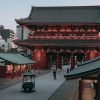 Rumors say Tokyo’s Sensoji Temple sticks you with bad fortunes, so we bought 100 to find out
Rumors say Tokyo’s Sensoji Temple sticks you with bad fortunes, so we bought 100 to find out All-you-can-drink Starbucks and amazing views part of Tokyo’s new 170 meter-high sky lounge
All-you-can-drink Starbucks and amazing views part of Tokyo’s new 170 meter-high sky lounge More foreign tourists than ever before in history visited Japan last month
More foreign tourists than ever before in history visited Japan last month Studio Ghibli releases new action figures featuring Nausicaä of the Valley of the Wind characters
Studio Ghibli releases new action figures featuring Nausicaä of the Valley of the Wind characters New private rooms on Tokaido Shinkansen change the way we travel from Tokyo to Kyoto
New private rooms on Tokaido Shinkansen change the way we travel from Tokyo to Kyoto Starbucks reopens at Shibuya Scramble Crossing with new look and design concept
Starbucks reopens at Shibuya Scramble Crossing with new look and design concept Studio Ghibli glasses cases let anime characters keep an eye on your spectacles
Studio Ghibli glasses cases let anime characters keep an eye on your spectacles Studio Ghibli releases Kiki’s Delivery Service chocolate cake pouches in Japan
Studio Ghibli releases Kiki’s Delivery Service chocolate cake pouches in Japan New definition of “Japanese whiskey” goes into effect to prevent fakes from fooling overseas buyers
New definition of “Japanese whiskey” goes into effect to prevent fakes from fooling overseas buyers Our Japanese reporter visits Costco in the U.S., finds super American and very Japanese things
Our Japanese reporter visits Costco in the U.S., finds super American and very Japanese things Studio Ghibli unveils Mother’s Day gift set that captures the love in My Neighbour Totoro
Studio Ghibli unveils Mother’s Day gift set that captures the love in My Neighbour Totoro New Japanese KitKat flavour stars Sanrio characters, including Hello Kitty
New Japanese KitKat flavour stars Sanrio characters, including Hello Kitty New Pokémon cakes let you eat your way through Pikachu and all the Eevee evolutions
New Pokémon cakes let you eat your way through Pikachu and all the Eevee evolutions Disney princesses get official manga makeovers for Manga Princess Cafe opening in Tokyo
Disney princesses get official manga makeovers for Manga Princess Cafe opening in Tokyo Sales of Japan’s most convenient train ticket/shopping payment cards suspended indefinitely
Sales of Japan’s most convenient train ticket/shopping payment cards suspended indefinitely Sold-out Studio Ghibli desktop humidifiers are back so Totoro can help you through the dry season
Sold-out Studio Ghibli desktop humidifiers are back so Totoro can help you through the dry season Japanese government to make first change to romanization spelling rules since the 1950s
Japanese government to make first change to romanization spelling rules since the 1950s Ghibli founders Toshio Suzuki and Hayao Miyazaki contribute to Japanese whisky Totoro label design
Ghibli founders Toshio Suzuki and Hayao Miyazaki contribute to Japanese whisky Totoro label design Doraemon found buried at sea as scene from 1993 anime becomes real life【Photos】
Doraemon found buried at sea as scene from 1993 anime becomes real life【Photos】 Tokyo’s most famous Starbucks is closed
Tokyo’s most famous Starbucks is closed One Piece characters’ nationalities revealed, but fans have mixed opinions
One Piece characters’ nationalities revealed, but fans have mixed opinions We asked a Uniqlo employee what four things we should buy and their suggestions didn’t disappoint
We asked a Uniqlo employee what four things we should buy and their suggestions didn’t disappoint Princesses, fruits, and blacksmiths: Study reveals the 30 most unusual family names in Japan
Princesses, fruits, and blacksmiths: Study reveals the 30 most unusual family names in Japan Japanese bakery’s new Vegan Curry Bread is awesome enough to please even carnivores【Taste test】
Japanese bakery’s new Vegan Curry Bread is awesome enough to please even carnivores【Taste test】 The U.K. thinks Japanese curry is katsu curry, and people aren’t happy about it
The U.K. thinks Japanese curry is katsu curry, and people aren’t happy about it How to make a “curry rice bowl” using instant oatmeal instead of rice 【SoraKitchen】
How to make a “curry rice bowl” using instant oatmeal instead of rice 【SoraKitchen】 Japan’s biggest curry chain now offers a true vegetarian curry
Japan’s biggest curry chain now offers a true vegetarian curry Japan’s favorite curry rice restaurant teams up with convenience store for Super Spicy Curry Buns
Japan’s favorite curry rice restaurant teams up with convenience store for Super Spicy Curry Buns New dining out initiative enrols the Evangelion cast, stars themed dishes and merchandise
New dining out initiative enrols the Evangelion cast, stars themed dishes and merchandise Pitch-black Black Belt udon noodles are a visual roundhouse, but do they taste good?【Taste test】
Pitch-black Black Belt udon noodles are a visual roundhouse, but do they taste good?【Taste test】 A foray into canned food with Jasmine Rice & Thai Curry in a can from Japan’s Inaba Foods
A foray into canned food with Jasmine Rice & Thai Curry in a can from Japan’s Inaba Foods Is Muji’s most expensive instant curry worth its price?【Taste test】
Is Muji’s most expensive instant curry worth its price?【Taste test】 We try an easy, cheesy, Italian-inspired camp meal using instant noodles【Recipe】
We try an easy, cheesy, Italian-inspired camp meal using instant noodles【Recipe】 The best Japanese curry in Japan isn’t eaten at a restaurant
The best Japanese curry in Japan isn’t eaten at a restaurant English-language Reddit falls in love with curry restaurant– Can it win our taste tester’s heart?
English-language Reddit falls in love with curry restaurant– Can it win our taste tester’s heart? Curry Bread Cider: A drink with an unforgettable aftertaste【Taste Test】
Curry Bread Cider: A drink with an unforgettable aftertaste【Taste Test】 Twitter user shares her cakey creation that looks just like a plate of curry rice
Twitter user shares her cakey creation that looks just like a plate of curry rice 103-year-old Japanese curry rice restaurant got dish right a century ago, still serves it today
103-year-old Japanese curry rice restaurant got dish right a century ago, still serves it today
Leave a Reply